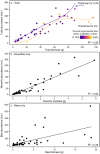Are Findings of Key Insect Metrics Generalizable Across Different Taxa in Malaise Trap Samples?
- PMID: 40823050
- PMCID: PMC12355040
- DOI: 10.1002/ece3.72006
Are Findings of Key Insect Metrics Generalizable Across Different Taxa in Malaise Trap Samples?
Abstract
Recent reports of insect declines and drivers thereof are often based on total biomass from Malaise traps. However, it remains unclear whether these changes reflect shifts in other community metrics (e.g., total abundance) and important taxa, such as key pollinators. To address this question, we collected Malaise trap samples from four different habitats (forest, urban, agriculture and open land) and four seasons (early spring, late spring, midsummer and early autumn) during 2019-2021. We measured the total biomass of each sample, then morphologically identified the insects in each sample, comprising 533,128 total individuals. We determined whether changes in total biomass reflected changes in total community abundance, and whether community relationships to habitat characteristics of land cover, weather/climate, and flowering plants were the same between the most common insects (represented by 15 different taxonomic groups) versus relatively fewer focal pollinators, specifically bees, butterflies, and hoverflies. Biomass was generally related to abundance, except in a small subset of communities comprising more larger-bodied taxa. Additionally, both overall community composition and pollinator composition were explained by the same weather and climate variables and the same habitat characteristics. However, pollinator relationships to habitat were likely driven by different mechanisms, specifically covarying changes in flowering plants. Our results suggest that patterns in Malaise trap biomass, and the relationships of prominent taxa to habitat characteristics, could be used to infer similar changes in other important community metrics and taxa, including pollinators. However, some insects responded to shifts in habitat characteristics for different underlying reasons, indicating the need for caution when using such inferences to inform conservation and management to ensure the correct mechanisms are being addressed.
Keywords: biomass; community; insect; malaise trap; pollinator.
© 2025 The Author(s). Ecology and Evolution published by British Ecological Society and John Wiley & Sons Ltd.
Conflict of interest statement
The authors declare no conflicts of interest.
Figures









References
-
- Amiet, F. , and Krebs A.. 2019. Bienen Mitteleuropas: Gattungen, Lebensweise, Beobachtung. Haupt Verlag.
-
- Bartoń, K. 2024. “MuMIn: Multi‐Model Inference. R Package Version 1.47.5.” https://CRAN.R‐project.org/package=MuMIn.
LinkOut - more resources
Full Text Sources

